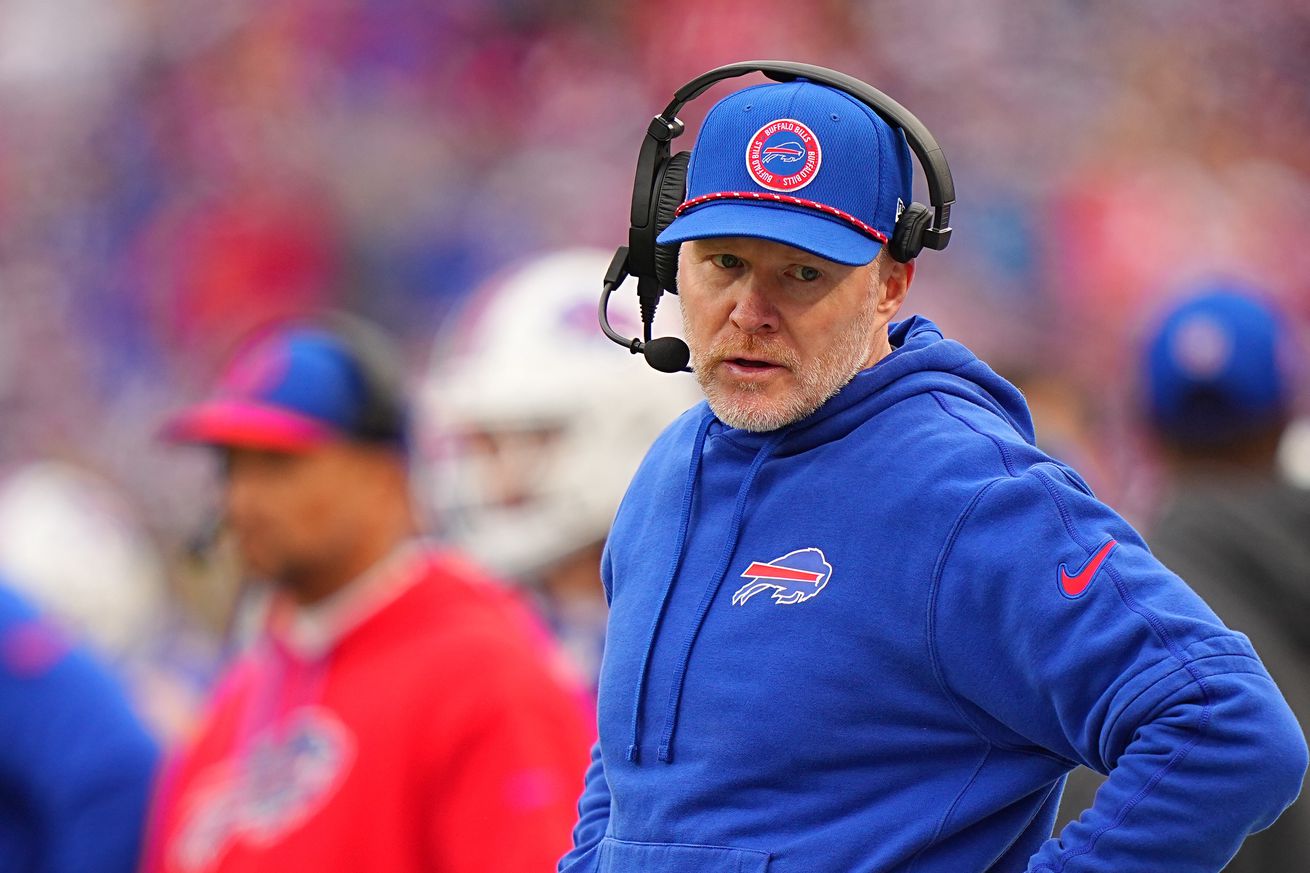
It’s not the count, it’s the Harm
The Buffalo Bills hosted the Miami Dolphins in Week 9 and on the surface it looked like a good day for flags. That’s true when it comes to traditional measures, but y’all know we don’t stick to traditional measures ‘round these parts.
Thanks to the small volume, we’ll be able to dive into the particulars of each flag and even go into the vault for a conversation item or two.
Standard and Advanced Metrics
Penalty Counts
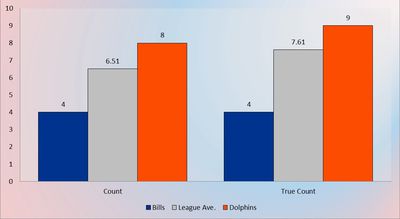
This is all pretty normal. That’s weird, because the Bills have historically struggled to stay close to average. But this year, this is normal — or at least more normal than the two games where they went “YOLO” and collected flags like Pokémon.
The Dolphins are technically above the league average but close enough to call it average. Speaking of average, the league has remained pretty stable for a few weeks. We’re still a bit higher than last year, but with close to half a season to go, there’s room for it to fall a bit — but it’s worth watching.
Penalty Yards
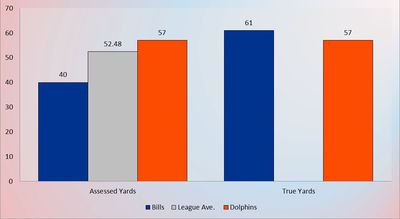
After looking at the counts above, the set of bars on the left is pretty much as expected. On the right side, we have our first glimmer of a deeper story. The Bills added over 50% more yardage to their total when factoring in negated yards, whereas the Dolphins negated zero yards.
Penalty Harm
Miami Dolphins
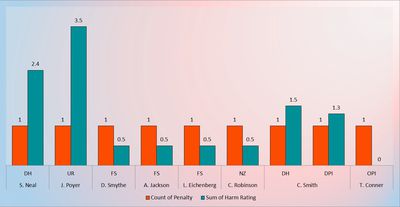
The Dolphins had 10.7 Harm total, which is barely above the bad day line of 10.0 Harm. I generally don’t break down a ton of opposing flags as they’re all wicked, wicked human beings who deserve to be called out on their evil ways. That said, sometimes there are a few worth discussing.
Cornerback Cam Smith had two flags on one drive, both of which come with free first downs. Only one actually gave up a down though (the defensive holding came on second down). Both helped the Bills drive down the field. It’s noteworthy that Smith’s were on the same drive as the Bills’ holding calls discussed below. Ultimately, Smith’s flags didn’t lead to a touchdown but they sure didn’t help the Dolphins.
The two most impactful ones were courtesy of former Buffalo Bills. Cornerback Siran Neal was called for defensive holding on 3rd & 6 where quarterback Josh Allen’s pass to wide receiver Keon Coleman was incomplete. The flag continued Buffalo’s drive, which did end in a touchdown. So thank you Siran Neal!
Safety Jordan Poyer’s unnecessary roughness has been broadcast all over and I’m not going to show it to you again. Poyer’s flag gave up two free downs, and continued Buffalo’s game-winning drive so kind of thanks except he injured Keon Coleman. Fun fact; Poyer was flagged for unnecessary roughness the first time the Bills played the Dolphins when he went low and hit wide receiver Khalil Shakir helmet to helmet while making a catch. That one was a little more bang-bang than the Coleman one, but it’s a fact worth bringing it up.
For, um, no particular reason at all here’s a GIF of quarterback Matt Ryan from 2021 initiating a slide head first and failing to score a touchdown as a result. Since we just brought him up, Ryan taunted Jordan Poyer and pushed the Falcons back, further costing his team.
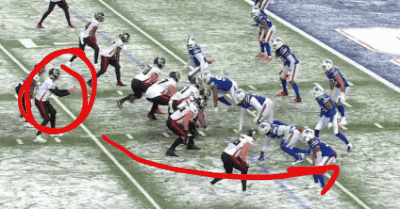
Here’s a potentially relevant play to discuss from a more recent game.
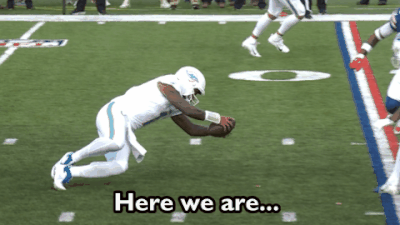
OK, fine. Quarterback Tua Tagovailoa likely reached the line before the shin touched. Let this be a reminder though that giving yourself up headfirst is still giving yourself up.
Buffalo Bills
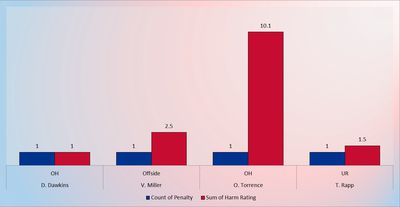
Buffalo had 15.1 Harm total, which is solidly over the bad-day line. The chart makes it clear where the primary culprit is. Since there’s only four total and none of them were false starts, let’s take a look at and dissect each of them. We’ll do these chronologically because that’s as good of an order as anything else. That means we kick things off with safety Taylor Rapp’s unnecessary roughness call.
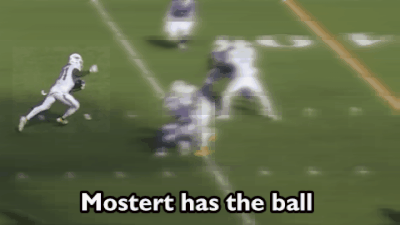
As the site’s official ref apologist, how do I feel about this call? I ****ing hate it. Stop me if you’ve heard this before, but there is NO such thing in the NFL as a helmet-to-helmet rule. Helmet-to-helmet can be a flag, but it’s always accompanied by other conditions as part of another rule. A common condition is a defenseless player such as a receiver trying to make a catch. Am I right, Jordan Poyer? Above, running back Raheem Mostert had caught the ball and clearly established himself as a runner, so he gets no special protections.
Making it worse, I know the GIF loses some resolution, but Rapp was trying to slow down for the impact and even more importantly you can see from the logo on his helmet he had his eyes up. Rapp was literally engaging in the “heads up” tackling form the league has been advocating for, for years. Mostert on the other hand goes full-steam ahead with eyes down and his back flat and parallel to the ground. This is a flag by rule, but it should be on Mostert and called as lowering the head to initiate contact.
This was flagged for yards only with Mostert already having the first. Arguably, Miami may still get a field goal without this flag but it still makes me angry.
Before we look at the holding call on left tackle Dion Dawkins, this one was assessed yards only. The call on the field was incomplete pass, so there’s no negated yards or points or anything for the official tally.
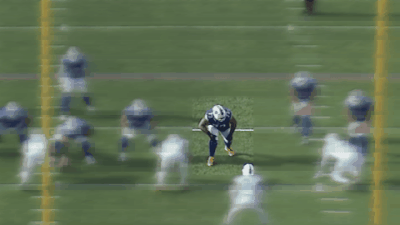
This call is also bull****. There’s no indication that Dawkins pulled his man to the ground. Offensive holding prohibits twisting, jerking, or tackling, but it does not prohibit letting your opponent lean in way too far and then retracting your arms and watching him fall on his face, and having a good laugh at his expense. This is a fantastic play from Dawkins and the ref is seeing things that simply aren’t there. What makes this a bull**** call rather than just a poor one is the fact that the rulebook specifically states that you do not throw the flag unless you see all elements of the penalty clearly.
The call on right guard O’Cyrus Torrence was the most impactful of the day, negating 21 yards of Josh Allen running and of course the ol’ touchdown that was scored on the play. Was this one valid?
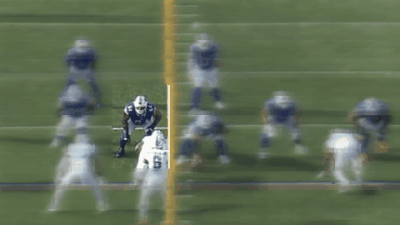
That one’s even worse. To call holding, there needs to be a material restriction. A twist, a jerk, anything that shows the lineman is directly and significantly impacting the other person’s trajectory. There is zero indication of that and the touchdown should have counted.
We have one more to go, but before we get to the offside penalty on edge rusher Von Miller, let’s talk about the impact. Miller’s five assessed yards came on 3rd & 3 and an incomplete pass by the Dolphins. Without this flag, it’s quite possible that the Bills get a stop and prevent a field goal.
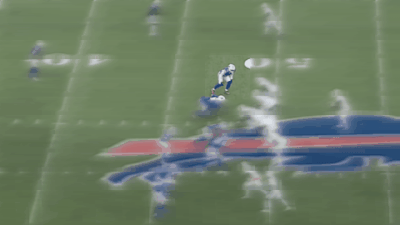
Hey, one out of four isn’t so bad for the refs, is it?